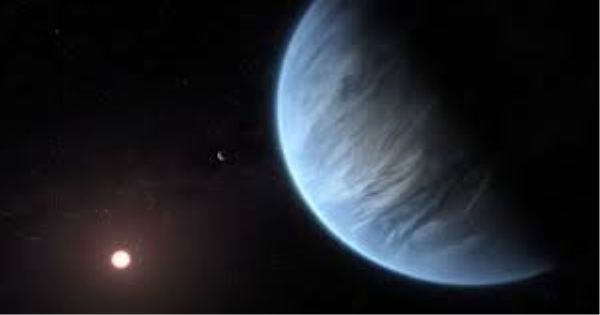In a groundbreaking advancement in space exploration, scientists have identified the strongest indicators of possible life ever discovered beyond Earth. Using the James Webb Space Telescope, researchers detected biologically linked gases in the atmosphere of a distant exoplanet named K2 B. This discovery marks a potential turning point in the search for extraterrestrial life.

What is Exoplanet K2 B
K2 B is a planet located outside our solar system. It revolves around a distant star and lies within the habitable zone, also known as the Goldilocks zone, where conditions may support liquid water, a key ingredient for life as we know it.
Key Facts about K2 B
| Feature | Details |
|---|---|
| Name | K2 B |
| Distance from Earth | 120 light years |
| Star System | Orbits a distant Sun-like star |
| Location | Within the habitable zone |
| Detected Gases | Dimethyl Sulfide DMS and Dimethyl Disulfide DMDS |
The Discovery of Biologically Related Gases
Gases Detected
-
Dimethyl Sulfide DMS
-
Dimethyl Disulfide DMDS
These gases are known to be produced by biological activity on Earth. On our planet, they are primarily emitted by marine microorganisms such as phytoplankton.
Detection Method
The James Webb Space Telescope was used to analyze the atmosphere of K2 B. Through spectroscopic analysis, researchers identified chemical signatures corresponding to DMS and DMDS.
Understanding the Importance of This Finding
Why This Discovery Matters
-
It is the strongest indication of potential life ever detected beyond our planet
-
It proves that current space technology can identify complex molecules on distant exoplanets
-
It shifts the focus in the search for life from simply finding water to detecting chemical biosignatures in planetary atmospheres
While these findings are promising, scientists have emphasized that they do not yet prove the presence of living organisms. More studies and observations are needed to confirm the biological origin of the gases.
The Scientific Reaction
Professor Nikku Madhusudhan, an astrophysicist at Cambridge University and lead author of the research, shared insights during a press briefing. He emphasized a mix of caution and excitement, stating that these are the first strong signs that an alien world may potentially support life.
He added that this discovery represents a major shift in the search for life beyond Earth. According to him, it shows that it is now possible to detect biosignatures on exoplanets using existing technology.
What is Dimethyl Sulfide and Dimethyl Disulfide
Dimethyl Sulfide DMS
-
A sulfur-based compound
-
On Earth, produced mostly by marine microorganisms
-
Plays a role in cloud formation and climate regulation
Dimethyl Disulfide DMDS
-
A more complex sulfur compound
-
Found in decaying biological material
-
Presence suggests biological activity when combined with DMS
The simultaneous detection of both DMS and DMDS is significant because their presence is strongly tied to microbial life on Earth.
What Comes Next in the Search for Life
Future Steps
-
Conduct further observations using the James Webb Telescope and other instruments
-
Rule out non-biological sources such as volcanic activity or chemical reactions
-
Use computer models to better understand atmospheric processes on K2 B
-
Encourage global scientific collaboration to validate findings
While the findings are not final proof of life, they represent a meaningful advance in the field of astrobiology.
Implications for Future Space Missions
The detection of potential biosignatures on K2 B proves that modern telescopes can analyze atmospheres of distant exoplanets with a high degree of sensitivity. This opens up many possibilities for space agencies to prioritize missions that focus on identifying habitable environments and signs of life.
It also highlights the importance of investing in scientific research and technological development in space observation tools.
Summary of Key Points
What Has Been Discovered
-
Two gases linked to biological activity, DMS and DMDS, have been found
-
These gases were detected in the atmosphere of a distant exoplanet, K2 B
-
The detection was made using the James Webb Space Telescope
What It Suggests
-
These gases could indicate possible microbial life
-
The discovery marks the strongest sign of life outside our solar system so far
-
Scientists stress the need for further verification and caution
The discovery of possible biosignatures on the exoplanet K2 B could be one of the most significant moments in the history of space exploration. It marks a new era in the quest to answer one of humanity’s oldest questions — are we alone in the universe?
Although the presence of DMS and DMDS is not yet definitive evidence of life, it is a critical step forward. With more research, this discovery could pave the way for understanding the possibilities of life beyond Earth.
We are now entering an observational era in astronomy, where finding habitable worlds and potential signs of life is not just theoretical — it is becoming a reality.
Ilmkidunya
Top Contributors
Related Articles
Pakistan Announces Major IT Initiatives to Boost Digital Transformation and Investment
- Ilmkidunya
- 17/Apr/2025
Samsung Galaxy A56 Leads Trending Smartphones | Oppo Find X8 Ultra Enters Top 10
- Ilmkidunya
- 16/Apr/2025








.gif)


































